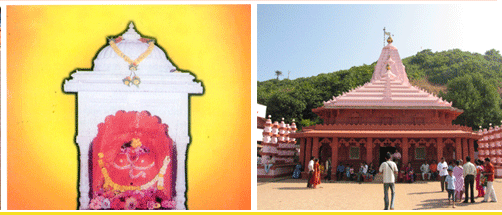



| Hotels In Ganpatipule |
The Legend Ganpati from Agargule has come to Pule, sixteen kilometers, south of Ratnagiri is Pawas, a place of pilgrimage due to the residence of Swami Swaroopanand' saint. And five km from Pawas, Village Agargule is situated, now known as Ganeshgule, Ganpati at Pule is situated on the sands of seashore at the foot hills while at Ganeshgule it is on the hills by the side of seashore, an ancient place. The legend is, both at Gule and Pule Ganesh is shapeless and 'Dhundiraj' image very much alike. The temple at pule is facing south generally, idols do not face south. Moreover, the inner most place is all around air tight (No ventilation) and possibly at this place a worshipper of Ganesh might have taken live (Sanjeevan) Samadhi (to bury one self). The shapeless sheela (stone) known as Ganpati might have been a door-sheela of this Sanjeevan Samadhi. It is a folk-lore and is an historical mystery. The only conclusion that can be drawn from this folklore that Ganesh before coming to light at pule, was at Ganeshgule and famous amongst Ganesh worshipper. The temple with a grass roof, erected by Shri.
Bhide for the idol Ganesh has become famous by its magnanimity,
self generated (Swayambhoo) and ever awakened state of sanctity.
The worshippers of Ganesh started visiting the sacred shrine for
relief from problems and get blessings for happiness and prosperity.
People had a profound faith in Ganesh due to its extraordinary effects
of blessings. In short space of time its fame came to the notice
of various kingdoms. One minister, Shri. Annaji Datto from the cabinet
of ministers, of the founder of Swarajya, Gobrahman, Pratipalak
Chatrapti Shivaji Maharaj, visited this shrine of Ganesh, as per
his orders renovated the temple removing the grass roof. The inner
most portion of the temple, the adytum (Gabhara) was built of stone
with a dome over it. The new adytum has been built in December 2002,
with a frame of white marble, that we see today. We come to hear
number of tales traditionally told to next generation about pule's
self generated (Swayambhoo) Ganesh. Most of them are not substantiated
by historical documents. Even then, they cannot be discarded as
fake. There is a tale (story) that Chatrapati Shivaji, whenever
he was to go on campaign, with profound faith used to worship and
take blessings of Shree Ganesh. He had a respect for and a faith
in religion, god and humanity. His preceptor (teacher) saint Samarth
Ramdas used to say:
'One who does any Karm, there should be a bidding of godly feeling and that is the strength of the Karm.' According to the advice of Saint Ramdas, Chatrapati Shivaji was conducting himself. At the time of conquest of English warehouse at Rajapur on the seashore of Konkon. Chatrapati Shivaji came to Ganpatipule with his fleet of Navy. He anchored his Naval Ships in front of Ganesh temple and along with selected armed personnel went inside the temple to take blessings of Shree Ganesh and then sailed to Rajapur port. He returned victorious as per his plan from the conquest fully satisfied. If this is substantiated by historical records, it is a matter of pride and it will be a page in golden letters in the history of this Ganesh temple. |
